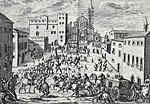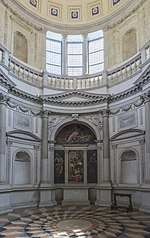Basilica of San Zeno, Verona
10th-century churches in Italy5th-century churchesBasilica churches in VenetoChurches completed in 1398Minor basilicas in Veneto ... and 4 more
Monasteries in VenetoRoman Catholic churches in VeronaRomanesque architecture in VeronaTowers in Italy

The Basilica di San Zeno (also known as San Zeno Maggiore or San Zenone) is a minor basilica of Verona, northern Italy constructed between 967 and 1398 AD. Its fame rests partly on its Romanesque architecture and partly upon the tradition that its crypt was the place of the marriage of Shakespeare's Romeo and Juliet. It stands adjacent to a Benedictine abbey, both dedicated to St Zeno of Verona.
Excerpt from the Wikipedia article Basilica of San Zeno, Verona (License: CC BY-SA 3.0, Authors, Images).Basilica of San Zeno, Verona
Piazza San Zeno, Verona San Zeno
Geographical coordinates (GPS) Address External links Nearby Places Show on map
Geographical coordinates (GPS)
| Latitude | Longitude |
|---|---|
| N 45.4425 ° | E 10.979166666667 ° |
Address
Basilica di San Zeno Maggiore
Piazza San Zeno
37123 Verona, San Zeno
Veneto, Italy
Open on Google Maps










